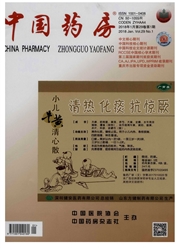

 中文摘要:
中文摘要:
目的:探讨他克莫司血药浓度监测在膜性肾病治疗中的意义。方法:41例膜性肾病患者服用他克莫司达到稳态血药浓度后,用酶扩大免疫分析法测定他克莫司血药谷浓度,对患者进行随访,记录临床治疗效果,应用统计学软件SPSS 16.0分析他克莫司血药浓度与临床疗效的相关性。结果:完全缓解(CR)组的他克莫司平均血药浓度为(7.47±2.74)ng/ml,部分缓解(PR)组为(5.72±1.19)ng/ml,无缓解(NR)组为(3.30±1.08)ng/ml,总缓解率为75.61%。CR组血药浓度最高,其次为PR组,NR组明显低于前二者,三者两两比较差异有统计学意义(P〈0.05)。结论:他克莫司治疗膜性肾病的临床疗效与血药浓度相关,监测全血他克莫司谷浓度在膜性肾病治疗中具有重要的临床指导意义。
 英文摘要:
英文摘要:
OBJECTIVE:To investigate the significance of tacrolimus blood concentration monitoring to the therapy of membranous nephropathy. METHODS:41 patients with membranous nephropathy received tacrolimus,and the blood concentration of tacrolimus reached to steady state. The trough concentration of tacrolimus was determined by EMIT. The patients were followed up,and clinical therapeutic efficacies were recorded. The relationship of blood concentration of tacrolimus with clinical efficacy was evaluated by SPSS 16.0 software. RESULTS:The blood concentration of tacrolimus was(7.47±2.74)ng/ml in complete remission(CR)group,(5.72±1.19)ng/ml in partial response(PR)group,and(3.30±1.08)ng/ml in no response(NR)group,with total remission rate of 75.61%. The blood concentration of CR group was the highest,followed by PR group and NR group,there was statistical significance among 3 groups(P0.05). CONCLUSIONS:The clinical efficacy of tacrolimus in the treatment of nephrotic syndrome is correlate to the blood concentration intimately. Trough concentration monitoring of tacrolimus has important significance to the treatment of membranous nephropathy.
 同期刊论文项目
同期刊论文项目
 同项目期刊论文
同项目期刊论文
 期刊信息
期刊信息
